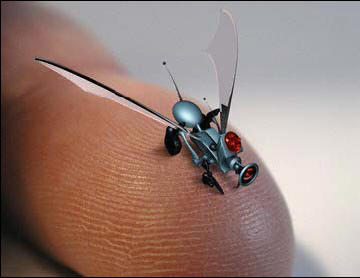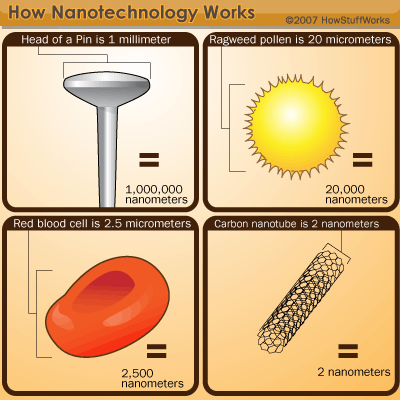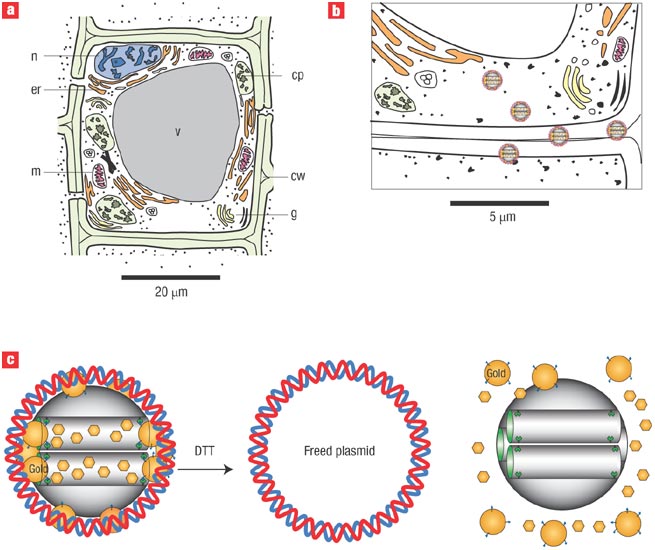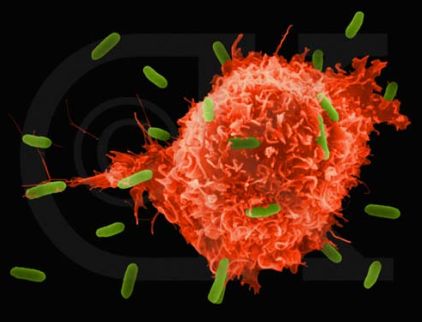Nanotechnology Impact
The impact of nanotechnology extend from its medical, ethical, mental, legal and environmental applications, to fields such as engineering, biology, chemistry, computing, materials science, military applications, and communications.
Major benefits of nanotechnology include improved manufacturing methods, water purification systems, energy systems, physical enhancement, nanomedicine, better food production methods and nutrition and large scale infrastructure auto-fabrication.
Nanotechnology’s reduced size may allow for automation of tasks which were previously inaccessible due to physical restrictions, which in turn may reduce labor, land, or maintenance requirements placed on humans.
It manipulates the chemical and physical properties of a substance on molecular level. The impact of nanotechnology extend from its medical, ethical, mental, legal and environmental applications, to fields such as engineering, biology, chemistry, computing, materials science, military applications, and communications.
Major benefits of nanotechnology include improved manufacturing methods, water purification systems, energy systems, physical enhancement, nanomedicine, better food production methods and nutrition and large scale infrastructure auto-fabrication. Nanotechnology’s reduced size may allow for automation of tasks which were previously inaccessible due to physical restrictions, which in turn may reduce labor, land, or maintenance requirements placed on humans.
Schematic illustration of nanotechnology revolutionising biomedical sciences.
Potential risks include environmental, health, and safety issues; transitional effects such as displacement of traditional industries as the products of nanotechnology become dominant; military applications such as biological warfare and implants for soldiers; and surveillance through nano-sensors, which are of concern to privacy rights advocates. Whether nanotechnology merits special government regulation is a controversial issue.
Nanobiotechnology is the unification of biotechnology and nanotechnology. This hybrid discipline can also mean making atomic-scale machines by imitating or incorporating biological systems at the molecular level, or building tiny tools to study or change natural structure properties atom by atom. Nanobiotechnology can have a combination of the classical micro-technology with a molecular biological approach. Biotechnology deals with metabolic process with microoraganisms. The biomedical applications of nanotechnology are the direct products of such convergences.
However, the challenges facing scientists and engineers working in the field of nanotechnology are quite enormous and extraordinarily complex in nature. Utility of nanotechnology to biomedical sciences imply creation of materials and devices designed to interact with the body at sub-cellular scales with a high degree of specificity.
Health issues
The health impact of nanotechnology are the possible effects that the use of nanotechnological materials and devices will have on human health. As nanotechnology is an emerging field, there is great debate regarding to what extent nanotechnology will benefit or pose risks for human health. Nanotechnology’s health impact can be split into two aspects: the potential for nanotechnological innovations to have medical applications to cure disease, and the potential health hazards posed by exposure to nanomaterials.
Nanotoxicology is the field which studies potential health risks of nanomaterials. The behavior of nanoparticles is a function of their size, shape and surface reactivity with the surrounding tissue. Apart from what happens if non-degradable or slowly degradable nanoparticles accumulate in organs, another concern is their potential interaction with biological processes inside the body: because of their large surface, nanoparticles on exposure to tissue and fluids will immediately adsorb onto their surface some of the macromolecules they encounter.
Health and environmental issues combine in the workplace of companies engaged in producing or using nanomaterials and in the laboratories engaged in nanoscience and nanotechnology research. Nanomedicine is the medical application of nanotechnology. Nanomedicine seeks to deliver a valuable set of research tools and clinically helpful devices in the near future. Neuro-electronic interfaces and othernanoelectronics-based sensors are another active goal of research. Further down the line, the speculative field of molecular nanotechnology believes that cell repair machines could revolutionize medicine and the medical field.
Environmental issues
Nanopollution is a generic name for all waste generated by nanodevices or during the nanomaterials manufacturing process. It can float in the air and might easily penetrate animal and plant cells causing unknown effects. To properly assess the health hazards of engineered nanoparticles the whole life cycle of these particles needs to be evaluated, including their fabrication, storage and distribution, application and potential abuse, and disposal.
The impact on humans or the environment may vary at different stages of the life cycle. Environmental assessment is justified as nanoparticles present novel (new) environmental impacts. Scrinis raises concerns about nano-pollution, and argues that it is not currently possible to “precisely predict or control the ecological impacts of the release of these nano-products into the environment.”
Nanofiltration, based on the use of membranes with extremely small pores smaller than 10 nm (perhaps composed of nanotubes) are suitable for a mechanical filtration for the removal of ions or the separation of different fluids. Furthermore, magnetic nanoparticles offer an effective and reliable method to remove heavy metal contaminants from waste water. Using nanoscale particles increases the efficiency to absorb the contaminants and is comparatively inexpensive compared to traditional precipitation and filtration methods.
Societal impact
Beyond the toxicity risks to human health and the environment which are associated with first-generation nanomaterials, nanotechnology has broader societal impact and poses broader social challenges. Social scientists have suggested that nanotechnology’s social issues should be understood and assessed not simply as “downstream” risks or impacts. Many social scientists and organizations in civil society suggest that technology assessment and governance should also involve public participation
Corporations are already taking out broad-ranging patents on nanoscale discoveries and inventions. For example, two corporations, NEC and IBM, hold the basic patents on carbon nanotubes, one of the current cornerstones of nanotechnology. Carbon nanotubes are poised to become a major traded commodity with the potential to replace major conventional raw materials.
Impact of Nanotechnology on Drug Delivery
The emergence of nanotechnology platforms can enable development and commercialization of entirely new classes of bioactive macromolecules that need precise intracellular delivery for bioactivity. While both organic and inorganic technologies are under development, controlled-release polymer technologies and liposomes will likely continue to have the greatest clinical impact for the foreseeable future.
Health and safety impact from nanoparticles
The presence of nanomaterials (materials that contain nanoparticles) is not in itself a threat. In addressing the health and environmental impact of nanomaterials we need to differentiate between two types of nanostructures: (1) Nanocomposites, nanostructured surfaces and nanocomponents (electronic, optical, sensors etc.), where nanoscale particles are incorporated into a substance, material or device (“fixed” nano-particles); and (2) “free” nanoparticles, where at some stage in production or use individual nanoparticles of a substance are present. There seems to be consensus that, although one should be aware of materials containing fixed nanoparticles, the immediate concern is with free nanoparticles.
This poses significant issues for addressing the health and environmental impact of free nanoparticles. To complicate things further, in talking about nanoparticles it is important that a powder or liquid containing nanoparticles almost never be monodisperse, but contain instead a range of particle sizes. This complicates the experimental analysis as larger nanoparticles might have different properties from smaller ones. Also, nanoparticles show a tendency to aggregate, and such aggregates often behave differently from individual nanoparticles.
Potential benefits and risks for developing countries
Nanotechnologies may provide new solutions for the millions of people in developing countries who lack access to basic services, such as safe water, reliable energy, health care, and education. TheUnited Nations has set Millennium Development Goals for meeting these needs. Potential opportunities of nanotechnologies to help address critical international development priorities include improved water purification systems, energy systems, medicine and pharmaceuticals,food production and nutrition, and information and communications technologies.
Protection of the environment, human health and worker safety in developing countries often suffers from a combination of factors that can include but are not limited to lack of robust environmental, human health, and worker safety regulations; poorly or unenforced regulation which is linked to a lack of physical (e.g., equipment) and human capacity (i.e., properly trained regulatory staff). The majority of nanotechnology research and development - and patents for nanomaterials and products - is concentrated in developed countries (including the United States, Japan, Germany, Canada and France). Producers in developing countries could also be disadvantaged by the replacement of natural products (including rubber, cotton, coffee and tea) by developments in nanotechnology. These natural products are important export crops for developing countries, and many farmers’ livelihoods depend on them.
Effects on laborers
Ray Kurzweil has speculated in The Singularity is Near that people who work in unskilled labor jobs for a livelihood may become the first human workers to be displaced by the constant use of nanotechnology in the workplace, noting that layoffs often affect the jobs based around the lowest technology level before attacking jobs with the highest technology level possible.It has also been speculated that nanotechnology may give rise to nanofactories which may have superior capabilities to conventional factories due to their small carbon and physical footprint on the global and regional environment.
The miniaturization and transformation of the multi-acre conventional factory into the nanofactory may not interfere with their ability to deliver a high quality product; the product may be of even greater quality due to the lack of human errors in the production stages. Nanofactory systems may use precise atomic precisioning and contribute to making superior quality products that the “bulk chemistry” method used in 20th century and early 21st currently cannot produce. These advances might shift the computerized workforce in an even more complex direction, requiring skills in genetics, nanotechnology, and robotics.
Impact of molecular nanotechnology
Molecular nanotechnology is a speculative subfield of nanotechnology regarding the possibility of engineering molecular assemblers, machines which could re-order matter at a molecular or atomic scale. Regarding the risks from molecular manufacturing, an often cited worst-case scenario is “grey goo”, a hypothetical substance into which the surface of the earth might be transformed by self-replicating nanobots running amok. Here, the malignant substance is not nanobots but rather self-replicating organisms engineered through nanotechnology.
You might also like
| What is Nanotechnology? Nanotechnology and Applications Nanotechnology... | Nanotechnology in Food Could nanotechnology make a food? Nanotechnology... | What is Nanobiotechnology ? Nanobiotechnology - Meaning and Definition Bionanotechnology... | Nanotechnology in Cancer Nanotechnology and Cancer The use of nanotechnology... |





 Alloy Suppliers
Alloy Suppliers
 Aluminum
Aluminum
 Aluminum Extrusions
Aluminum Extrusions
 Copper-Brass-Bronze
Copper-Brass-Bronze
 Nickel
Nickel
 Magnets
Magnets
 Stainless Steel
Stainless Steel
 Stainless Steel Tubing
Stainless Steel Tubing
 Steel Service Centers
Steel Service Centers
 Titanium
Titanium
 Tungsten
Tungsten
 Wire Rope
Wire Rope